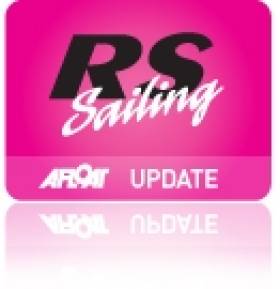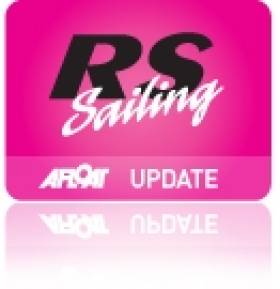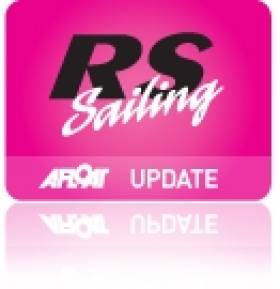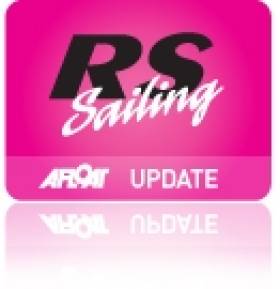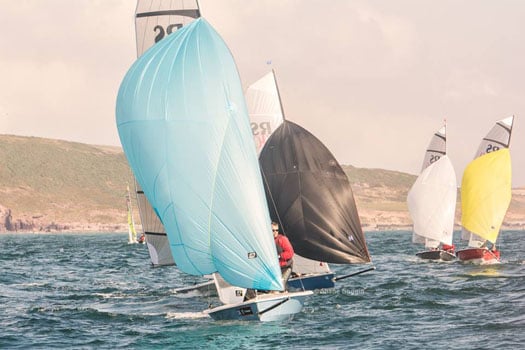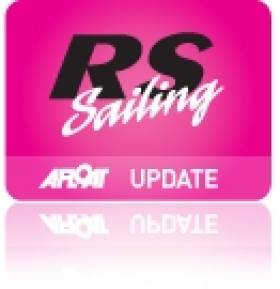Displaying items by tag: RS400
#laser – As 40 Laser dinghies enter the last few weeks of typically close racing in the perennial DMYC Frostbite series, dinghy sailors are looking forward to the warmer months, especially after some subtle but significant changes by Dublin Bay Sailing Club writes our Dublin Bay Laser fleet correspondent.
DBSC has been engaged in lengthy discussions with all dinghy classes and there are a few key format tweaks, including two new classes in the shape of the Laser (previously in PY) and the RS 200/400. The idea for Lasers is to focus everybody on Tuesday evenings for club racing, thereby freeing up weekends for other sailing (eg, Laser regattas or other DBSC classes) or indeed for family obligations. Some other DBSC dinghy classes, however, stick with the tried and trusted Saturday plus Tuesday format. Horses for courses and Hats Off to DBSC for a flexible approach.
Download poster below for more details of the new initiative.
But one thing's for sure ; the simple Laser formula is as popular as ever. A perfectly competitive boat is just €2k and the associated costs are very low. The healthy exercise from hiking and working a Laser is catching the Fitness wave too and makes the single-hander a popular lifestyle choice for sailors who also cycle, run or whatever. In anything over 5 knots it's the ultimate full body workout ! In the last 18 months we're also seeing young graduates from the vibrant DL scene for the smaller 4.7 and Radial rigs. How great it is to see them transition into the local racing scene. Many of these younger sailors - like us older types (!) - are inspired by the international exploits of the Waterfront's own Annalise Murphy and Finn Lynch, who can be seen out training on the Bay, using exactly the same equipment as the rest of us.
So....Get that Laser out of the garden, or don't put it away after the Frostbites ! Join us on Dublin Bay for glorious Tuesday night racing and other events highlighted in the attachment. We want to see all ages and ability levels. We'll even lay on some coaching and we'll definitely meet up for a drink after racing each Tuesday.
RS Dinghy Sailing Continues to Build Across Ireland
#rssailing – Lots of enthusiastic experienced RS sailors are racing the new sailors on the block up and down the country writes David Rose of the Irish RS class association. The winter is being used more and more as an opportunity to sharpen up for the exciting summer circuits on offer, and the boats keep arriving on these shores in ever greater numbers.
2014 has been a fantastic year for the Irish 400 fleet. 2015 is already showing signs of shining even brighter. There has been a massive uptake in new 400's on order in the UK as the Irish are threatening to take over, by buying every good boat in sight on the market for the last few years. It has gotten to the stage that those who were responsible for the initial uptake in sailing these fast hiking double handers can now sit back and watch as the fleet takes on a momentum of its own.
I spoke to Ben Fusco who is involved in Feva training in Dublin. Ben - "We have 12-14 boats training regularly. We are looking at maybe 8-10 boats to go to the RS Feva worlds in Travemunde in Germany, as an Irish team. The season opener for 2015 is the confusingly named RStGYC Christmas Cracker on Feb 7th, we will have a separate Feva Start."
"We love the level of competition" - Emmet Ryan 2012 400 Champ. "The RS boats are fantastic, and we have had great fleets for many years now in Ireland. We hit a tipping point last season, it's really taken off. We are seeing many different generations of dinghy sailors converging on this class like never before. This is largely due to the wide competitive weight band for these boats, we have super light crews up against heavy crews and no matter what the wind speed, both can be competitive."
It is not all about the pointy end either, lots of teams of various standards are getting involved. There is an opportunity here for people with kids, to have a double stacker and turn up to an event with any combination of Feva, 200 and 400. Couples are a regular sight on the race course in both the 200 and the 400 classes, and we have had lady helms and crews competing well all season. All of this creates an atmosphere that is exciting and friendly. Events tend to have camping available where ever possible to keep costs to a minimum.
Meeting up with the UK fleets in sunnier places like 2014 Lake Garda in Italy, or in 2015, Carnac France, and you end up with a recipe for fun and success. There are also excellent training holidays available in the Canaries, with a full Range of RS boats. The UK events are very accessible next season and all the calendar details are available online. The Irish fleet are starting to record ever better results when mixing with the excellent UK scene. In the UK, the 200 nationals has over 100 boats and the 400 has 70+. Our Irish fleet sizes are very healthy too, our traveler's series recorded 31 RS200's seeing competitive action and 56 RS400's.
The RS scene in Ireland right now is all about well attended regional events and sprints (sprints are often one day and less formal), and travelling numbers have been great, but there is also a growing local racing scene in the bigger hubs of Belfast, Dublin, Cork and Limerick. There are plans to have excellent training in these locations next season as well as regular fleet racing.

The RS classes are delighted to be involved in the Mixed Dinghy week in the Royal Cork Yacht Club. The RCYC has been a great supporter of the RS classes in the last few years and the 400 Southern champs will be part of the event along with the 200 and Feva National championships. This has the effect of allowing some sailors to take part in both the 400 Nationals and either the 200 or Feva main event. The 400 Nationals is heading north this year to Ballyholme Yacht club.
Dave Cheyne comments on the 200 class. "We are starting to see a few more 200's arriving in Ireland for next season. I have bought one myself and look forward to racing it with my son. I will still campaign the 400, both boats have lots to offer."
Marty O'Leary who previously had a 400 is now fully focused on the 200 and won in impressive style at the well-attended southerns last year. He continues to show the boat to be competitive under yardstick racing in Dublin. I have been told that Marty is likely to include a few UK200 events next season and test himself against the very high standard on those shores also.
We expect the already good numbers in the Irish 200 fleet to grow quickly next season as so many more people have been exposed to the RS scene in Ireland. Keep an eye out for test days at your club. This is an exciting year for the 200 as the boats are getting an updated sail plan that includes a fully transparent main bringing their looks up to date and making it easier to see traffic.

RS Fleet DMYC Frostbite Dinghy Racing Continues With Two Races on Sunday
#rssailing – A cold north-westerly wind greeted the Dun Laoghaire RS400 fleet as they ventured out to the start line of the 2015 DMYC Frostbites. With reports of 25-30 knots from boats competing in the Spring Chicken series early in the morning.
With 2 races scheduled and a dying wind the committee and mark laying boats set a short but challenging course spread through the harbour.
At the go most of the fleet fought for the best committee boat position some deciding to stay out of trouble and venture further down the line from the main pack, this lead to the fleet splitting in two, on each side of the course. The fleet all converged at the windward mark. The fleet then power reached across the top of the harbour. The three pack leaders, of the Ryan brothers, Sean and Donal and Alexander and Kevin, all pulled off the synchronised gybe capsize so beautifully that they then spent the next ten minutes trying to untangle themselves, this left the race honours to the 200s to battle it out,
Alexander later recalled "What was a race of boatspeed now became a race of capsize recovery!" Team Cleary/Murphy were first to fully recover and went on to chase the new leading pack. The next two laps were a major catch-up for the three capsized boats with Team Cleary/Murphy reaching into the leading pack. Marty O'Leary and Rachel Williamson taking the honours after being pushed hard.
The start of the second race showed the eagerness of the 200 and 400 fleets with both being "Miles over" as said by Kenneth Rumball in the Fireball fleet. This prompted a general recall and a black flag to put some manners on the boats. The second start was clear with a quick tack onto port by Team Cleary/Murphy and Team O'Leary and Williamson while the bulk of the fleet continued towards the HSS ferry terminal. Following a tack onto port by the fleet on the left side of the beat the leaders (team Ryan) emerged at the top mark. Most of the fleet learned from the previous race about the importance of keeping the boats upright so most of the fleet opted to hoist their kites once in the lee of the breakwater. The race was won on the water by team Ryan followed closely by Cleary/Murphy and Rumball/Brazel. In what was a very quick race, only 25 minutes to complete the three laps. This wasn't enough for the 400s to stretch their legs, and again the 200s took the overall Honours.
This weeks weekly mug went to, Chris Helme and Alan Claffey for race 1 and Enzo Michel and Tom Gillan for race 2.
Thanks to Alexander Rumball for this weeks write up.
RS400 Adds to Kinsale Yacht Club Frostbite Series
#kinsaleyachtclub – Day two of the ASM Kinsale Yacht Club frostbite series saw typical frostbite weather, cold, bright, sunny with near perfect sailing conditions. The wind was 10–knots gusting to 12.5 from NNW. Each of the 5 fleets got 3 great races in shifting conditions which made it a great test for all competitors. Each of the fleets had close racing, especially the ever popular Squib Fleet.
Race Officer & KYC Sailing Secretary, John Stallard was delighted to see the arrival this week of the RS400 fleet which has added greatly to competition and made for a beautiful spectacle in the bright sunshine on Kinsale inner harbour.
Maeve Leonard from RCYC appeared out today in the Laser Radial fleet and produced 3 bullets to dispense with all opposition. Her club mate Luke McGrath achieved the same result in the Laser 4.7 fleet.
The Full rig fleet was smaller today and the field is led by Monkstown's Ronan Kenneally followed by Club mate Paul O'Sullivan.
In the Squib fleet KYC's Colm Dunne and Rob Gill have an astonishing result of 6 bullets after 6 races, they are hotly pursued by KYC's Commodore Finny O'Regan and his son Colm.
Sail number 1260 takes the lead in the fledgling RS400 fleet.
Racing continues next week....

Squibs on a Run
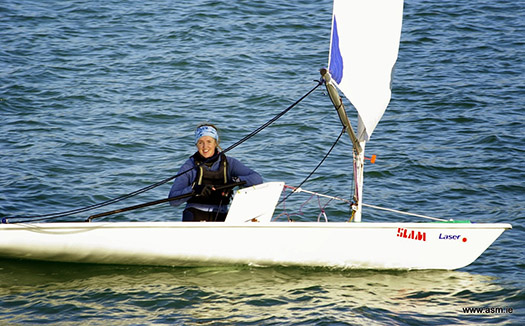
Maeve Leonard of RCYC looking happy with 3 wins from 3 races
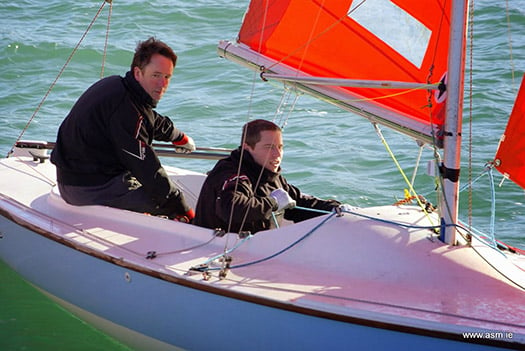
KYC's Colm Dunne & Rob Gill in their Squib Allegro, in the lead with 6 bullets after 6 races...
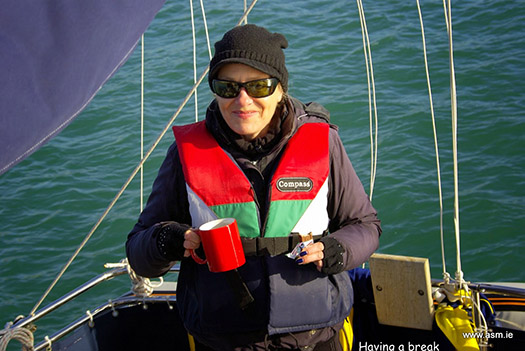
Committee Boat stalwart Sue Horgan

Lasers heading to Castlepark
All photos courtesy of Seamus McLaverty of ASM Marine
14–Boat 'Boisterous' RS Fleet Sailing in DMYC Frostbite Series
RSsailing – RS Sailors were on the water in Dun Laoghaire for yesterday afternoon's latest round of the DMYC dinghy Frostbite series writes Sarah Byrne.
With a lovely westerly breeze forecast on a crisp cloudless afternoon in the busy harbour, PRO Olivier opted for two races 'inside' on the default trapezoid. 14 boats on the RS start line proved boisterous and noisy at the Committee boat end, one OCS By Alexander Rumball in 1143 and a lone 200 owning the pin end.
The first beat proved uneventful with a cluster at the first mark and prompt hoists separating the wheat from the chaff down the first reach. At the second mark, some gybed away from the breeze bouncing around the HSS pier, only to arrive together again but with water at the next mark, then heading up onto a rather tight reach with some being forced to drop their kites. Multi fleet traffic forcing tacks spread the fleet further on the second beat. Marty & Rachel managed to maintain their lead throughout the four laps in the 200 fleet; Totts/Kelly battled with Enzo/Tom while Sarah/Katie hot in pursuit performed a particularly idiotic capsize to put them out of the race. Marty and Rachel came in just 1 second (on PY) behind the lead 400, Ross McDonald and Peter Bayly, taking joint second with Emmet and James Ryan.
Counting down to race two, with those in shorties beginning to get a bit chilly, the fleet were less unruly on the start line and again a lone boat owned the pin end. Two thirds up the first beat, the wind dropped and shifted a little to the north and hey ho a fishing boat comes barging through the fleet towards the first mark, messing it up a tad. Again Marty had made it first 200 to the top mark hunting down the new 400 pairing Sean Clery and Ronan Jones throughout and finishing together. Totts and Myles stayed just out of Sarah and Katie's reach for two of the three lap race when it was sadly and prematurely shortened as the Grannuaile demanded her passage through the course. On PY Marty and Rachel yet again owned the race, the Ryan Bros. and Andrew Algeo and Paul Nolan came in second and third overall.
Maeve Rafferty loving her new hull – thank you RS sailing! Quite the pleasant afternoon! The weekly Mug went to Ross McDonald and Peter Bayly for the first race and Emmet and James Ryan for the second race.
RS400s Take to Belfast Lough for Royal North Series
#rssailing – 13 RS 400s came to the Royal North of Ireland line yesterday, with boats coming from Cushendall, Dublin and Ballyholme. The RNIYC series runs for another six weeks, breaking for Christmas, then starting again for 12 weeks as the 'Frosties'.
RS 400, 200 & Feva Dinghy Finale Hits A High Note at Royal Cork Yacht Club
#rssailing – The Royal Cork Yacht Club was buzzing at the weekend, with what was a great precursor to next year's dinghy week. The RS fleets were in town for their final event of what has been a bumper Irish calendar full of well attended competitive and fun events by David Rose (RS-Association Ireland).
Tents were being welcomed and pitched on the lawn, and dinghies were arriving in great numbers on the Friday night and Sat morning. The weather was playing ball and giving us wind and the impression that it was still summer. The red carpet was rolled out by a club that draws on its people and facilities to run top class events in a really friendly way. Small details make these occasions and there was little left undone, with shore helpers and soup waiting at the top of the slip for competitors, and a few free pints to help ease the aching bones on the Saturday night. Celine McGrath not only ran the event ashore but also helped on board the OOD boat during the racing. Results were hitting the website as the boats were finishing, just another detail that makes a noticeable difference.
Barry Rose was our race officer and employed the great help of a top notch team, including Ciaran Mc Sweeney who had ran an excellent RS sprint event earlier in the year out of MBSC, and RCYC's Eddie Rice who along with the rest of the team provided exceptional racing, with no delays of any kind all weekend. The course was changed so fast when needed that the competitors hardly noticed, and everything from course length to the quality of the line was impeccable.
First order of business for Barry and his team was to decide which of the many race area's available in Cork would best suit the forecast on Saturday, and after going out on a rib before the briefing, he established that the conditions outside Roches Point, with a small swell and a nice breeze would provide the best racing.
The 40 teams in their double handed dinghies made a fantastic sight snaking out the Owenabue River and around Camden and then Roches to do battle on Sat Morning. When they arrived they found a course ready to go and once the last competitors had arrived, racing got under way in brilliant conditions that allowed for surfing downwind and good tactical upwind racing.
RS400 Race Report: 21 Teams, 6 Races, One discard
Race one saw RCYC's David Rose and Ian Hef lead the way for two rounds on home turf, until being reeled in and passed by John Downey and Sandy Rimmington (MBSC) and the ever present Sean Cleary and Steven Tyner on the final beat.
Race two saw National Champions Alex Barry and Richie Leonard record a bullet followed by Dave Cheyne and Stephen Kane (NDLL) who would remain consistent for the remainder of the regatta and gain a podium position of 3rd place overall.
Race three was all about Sean Cleary and Steven Tyner (GSC) who have had a fantastic season, including winning the Eastern's and recording a very credible 10th at the UK Nationals. For most of the race, they were challenged hard by John Downey and Sandy Rimmington, but there challenge was to end abruptly in a post weather mark incident that resembled losing a front wing in a formula one car. When the dust settled John's bowsprit was broken and they had to limp home in luckily for them the final race of the opening day.
Overnight Andrew Alego and P. Nolan (RSGYC) were well placed as was Andy Verso and Oisn Baugh (GSC). The racing had been close and there was a lot to play for on day two.
On day two Barry Rose decided that with a bigger swell and more breeze forecast it was prudent to race the fleet in harbour. Cuskinny is a great place to race with a strong easterly, and despite a more tidal race course, it was a great call, allowing the fleets to get in 3 more exhilarating races in great breeze, watched by a flotilla of motor boats and yachts that came out to see these exciting fleets in action.
Alex Barry and Richie Leonard had a fantastic battle with Sean Cleary and Steve Tyner in race four, and this would prove to the be order of business for the day.
David Rose and Ian Hef were back in the mix recording a two and a three in race five and six to finish fourth overall. Dave Cheyne and Stephen Kane were excellent in the conditions and a third and two sixths would earning them a well-deserved third overall.
For the top honours there was little between Alex and Richie and Sean and Steve, both teams battled hard all day, overtaking each other many times. This was a tight affair with no shortage of drama, including a swim in Race five for Alex and Richie, which they recovered from admirably.
Sean and Steve on "Yachtsman Euromarine" were in poll position going into the last race, but the margin was slim and Alex and Richie knew if they could overhaul their competitors in the final race they would win on count back, and that is ultimately what happened.
Alex Barry and Richie Leonard are 2014 Southern Champions.
Alex Barry's post event observation:
"It is very exciting to see RS dinghy sailing hitting great heights at the moment in Ireland. I hope to see the fleets in Cork again next year for Dinghy week. Thanks for great organisation and race management and to the RCYC for a great weekend."
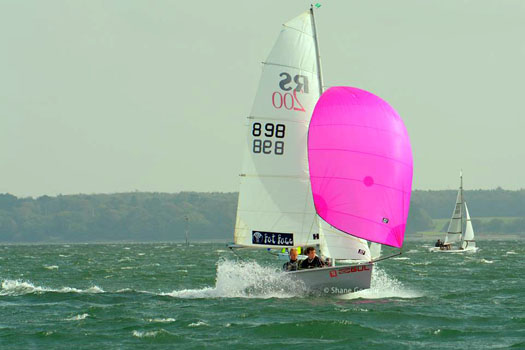
RS200 Race Report: 12 Teams, 6 Races, One discard
A good turnout for the final event of the season for the 200 fleet, made for some very competitive racing, and we may see a cork fleet develop next season in this exciting class. Ronan O'Driscoll and Shane Dunlea are sailing out of MBSC and many heads were turned in the RCYC at the weekend, by a boat that combines high performance and well worked out systems that are easy to use.
Day one was all about Marty O'Leary and Rachel Williamson (RSGYC), who mastered the conditions and dominated the fleet with a clean sweep of three race wins from three on day one. Marty had made the move from competing well in the 400 with Brian Fenlon recording an 8th at the Nationals in Galway this year.
Blair Stanaway and Heather King (RSGYC/Westport) were hanging in there with two seconds and a third to open, as were Stephen Craig and Conor Foley (RSGYC) with two thirds and a second.
It was to be more of the same from Marty and Rachel on day two, recording an impressive fourth race win from four, before allowing Blair and Heather to win the fifth race. Marty and Rachel however had now won the RS200 Southern title with a race to spare in a superb first outing.
Second was Blair and Heather two points back and third was Stephen Craig and Conor Foley a further five points adrift.
The 200 is a newer boat than the 400 and has a lower weight band being similar but slightly less powerful. The fleet in the UK is very large and strong, allowing easy access to affordable and fast second hand boats. There are also demo boats available in Ireland so please enquire if you are interested in getting involved. We are expecting growth next year country wide in this exciting class.
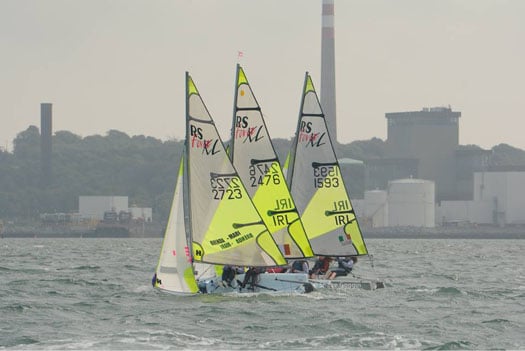
RSFeva Race Report: 9 Teams, 6 Races, One discard
The Feva class was full of RCYC competitors, making up over fifty percent of entries.
One of the bigger challenges of Day one was getting out to the race course through the tidal rush and sea one often gets in the entry to Cork harbour.
Once out there, the Feva's started an exciting series that saw Lorcan Tighe and Cian Murphy of NYC winning race one, with Dara Donnelly and Rosemar Tyrell (NYC/RIYC) second.
Donnelly and Tyrell were to finish second in the other two races of the day and were level on points with Sarah Cudmore and Kelly Williams (RCYC) after day one. Sarah and Kelly won race two and three and established themselves as favourites.
Day two, and to the in-harbour course and more wind. It was business as usual for Sarah Cudmore and Kelly Williams winning a further two races and taking the championship in fine style with a race to spare. Lorcan Tighe and Cian Murphey who sailed really well to three seconds on the Sunday were second overall, three points clear of Dara Donnelly and Rosemar Tyrell in Third. Suzi Fitzpatrick and Aine Riche (RCYC) won the final race to sit fourth.
Other honours went to first lady crew in the 400, Laura Holohan, she finished sixth overall with helm Paul McMahon. Sheela Lewis took first lady Helm and 14th overall in the 400 (John Lewis crewing). In the 200 Sarah Byrne took top lady Helm (crewed by Tom Gillan) and champion Rachel Williamson also took home top lady crew in the 200 (Marty O'Leary at the helm).
See here for full results
Galway Bay Sailing Showcases 60–Boat RS Nationals
#rssailing – Sixty one Feva's, RS200's and RS400's descended on Galway Bay Sailing Club (GBSC) from the 8th to the 10th of August to compete in what was each class's 2014 National Championships writes RS Ireland Class communication officer David Rose. This organisational marriage of classes from RS continues to work really well together and brings with it a wide range of sailors from all over Ireland. There were many new faces in all classes and the atmosphere was really inclusive and enthusiastic for the competition ahead.
GBSC was represented fantastically by its members with amazing support for the event. Launch and recovery was aided by a team of helpers, and the race officer and commodore David Vinnell and team were outstanding throughout, providing a tactical and interesting race course every time. All races were sailed in planing conditions. For the strong breezes, the sea was tame for the west coast, but was still challenging, as crews worked for each wave upwind and down. True beats and good lines make for great racing and we had them throughout.
RS Feva Nationals, 9 Races, 2 Discards, 15 Boats
The Feva is one of Ireland's most successful boats and they have become visible on the water sailing out of most of Irelands sailing clubs. They provide a platform for young people to race competitively in a high performance boat with a modern configuration and build that makes them damn near indestructible. The Nationals this year was a superb showcase for the boats, with young sailors coming together to fight it out on the same course as the larger 200 and 400's. This generation of two handed sailors look set to have a great impact on Irish sailing going forward.
The racing was excellent, and one team stood tall with an amazing display of speed, recording eight race wins and a fifth. It is always an outstanding achievement to discard a bullet, and that is just what happened for the Blessington SC team of Alison Dolan and Grainne Younge.
The battle for second was an altogether tighter affair, coming down to the last race and being edged by only a point by Grace O' Beirne and Helen O'Beirne of RstGYC over Triona Hinkson and Katherine kelly also of the RstGYC. Local sailors David Carberry and Ciaran Jordan showed great pace and represented the host club with a string of seconds and thirds to remain competitive in fourth.
Chatting in the dinghy park with the parents who help make this class tick, it was clear that the event had been a great success, with many teams camping around the club in all classes and the kids and adults alike having fun late into the evenings. The comparison was drawn to the Mirror hay days, and it's hard to ignore this fleet as an option to any parent wanting their kids to sail a boat that requires teamwork and that is exciting to campaign.
There are some great ideas for enhancing the RS Feva Circuit further next season, but if you feel you could help us with these please don't hesitate to get in touch, as we are at the planning stages for next season already.
RS-200 Nationals, 9 Races, 2 Discards, 14 Boats
Roy Van Maanen and Kevin O'Rourke (GYC) have dominated the RS200 Nationals from start to finish, recording an impressive 6 race wins and a second after discard.
Stephen Craig fought back on day two and three with a string of seconds and bullets but it was never going to be enough to outdo the other pairing. Graeme Noonan and Harry Noonan were consistent throughout and finished 3rd on 18 points, with Trevor Fisher and Heather Craig also in the vicinity on 21 points.
Congratulations also go to the John McKelvie and Sarah Watson, 2013 Irish National Champions for their strong showing in Garda recently recording a 9th in a strong 28 boat fleet.
This was competitive, fast and furious racing in a class that looks set to grow in 2015, as the profile of the RS sailing increases throughout Ireland and the many excellent features of the 200 become better known. This is a design that has advanced from the success of the RS400 and has a hugely strong UK and Irish fleet.
RS 400 Nationals - 9 Races, 2 Discards , 31 boats
In the 400 Class, after an opening day and 4 races, McCready Sailboats sailed by Gareth Flannigan and David Fletcher were showing the form of past and future champions and led clear of the pack. There was to be no resting on ones laurels however as several boats were still within striking distance with a gaggle of teams on 12 and 13 points overnight.
It had been a fast and furious day, with no let up from hiking after the weather mark, and no shortage of adrenaline as the fleet came thundering downwind trying to out gybe and think each other on lay-lines. With 3 rounds, there was ample time to work your way into better or worse positions on the race course.
Interestingly the following pack included sailors from every corner of Ireland, showing how strong the class has now become throughout the country, including "The Full Irish" single handed sailor Dave Kenefick who at his first event teamed up with Sandy Rimmington of MBSC eventually finishing 11th overall, David looking exhilarated after day one, described the boats as "all the fun of a 49er without the swims".
Day two was to be very similar and just as exciting and fun as day one. The story was of another team now sailing like champions and leading the pack. Alex Barry and Richard Leonard of MBSC and the RCYC were now sitting clear by a few points from Sean Cleary and Steven Tyner, the talented pair from GSC who were Eastern champions earlier in the season. Also a prominent challenger now was the UK pairing of Howard Farbrother and Dan Martin, who had featured well in the Europeans at Garda recording a seventh. Two Irish 400's had also made the trip to Garda for the Europa cup recently with Emmet Ryan and Jay Stacy finishing 10th and David Rose and Ian Heffernan Finishing 12th at that event and both teams were in the hunt here, as was the ever present Dave Cheyne and Richie McCullough. These teams were to fade away however by the end of day two when the final discard was applied after 8 races.
(Sean Cleary and Steven Tyner showing their class on day two) Day three was expected to be a huge storm, but the forecast had been inaccurate all week, and this appeared to be the case as the fleet launched in light air. This calm however was not to last long, and the race offers managed to squeeze in another exciting race for all classes, before an "End of the World" style storm cloud made for a spectacular and at intimidating scene in Galway bay. Visibility reduced and it blew very hard for a short period of time.
The Race officer had his regatta and called time on proceedings. It's a testament to the three classes that no rigs were lost for the entire event, and apart from some worried parents and competitors all was okay and the fleets got home safely to finish what had been a fantastic 3 days sailing out of GBSC.
When the dust settled, Alex and Richard of MBSC and RCYC had won the 400 Nationals, followed by Howard and Dan from QMSC and Sean and Steven in third. Alex had this to say after the event: "What a fantastic event, consistent breeze and excellent competition meant for exhilarating racing. The RS classes are the only place to be at the moment. It's great to see such prestigious sailors such as Ross McDonald and Dave Kenefick who had moved into the yachting scene back in dinghies and picking it up so fast. Thanks to all who were involved in the organisation of the event, delighted with the win, absolutely knackered now tho."
This movement of accessible high performance sailing dinghies continues to bloom, and be enjoyed by a wide variety of competitive and enthusiastic sailors of all ages.
We look forward to seeing you all at the final event of the season, the RS Southerns in Kinsale on the 13th and 14th of September 2014. For those on a budget consider the activity centre for hostel style accommodation. Kinsale is a great venue so please support the event
#rs400 – Royal St. George's Emmet Ryan is lying sixth in a fleet of 45 at the RS400 EuroCup at Fraglia del Garda, Italy after three races. Ryan, sailing with Jay Stacy, counts a 9, 6 , 6 at the Italian lake venue. The Dublin crew are one of two Irish boats competing. Royal Cork's David Rose and Ian Heffernan are 11th. Racing continues today. Full results are here.
#rssailing – There was a buzz in the Monkstown Bay SC dinghy park last Saturday morning writes David Rose. There was a real feeling of a fresh start for dinghy sailing in this part of the world, with 20 boats hitting the start line and many new teams competing for the first or second time in the Feva, RS200 and RS400 classes alongside seasoned campaigners. Overall results are available to download below.
There were some nerves and a lot of smiling faces as the teams got through the formalities of rigging and entering, which included a barbecue later that day to replenish the energy spent on the water.
It was clear from the forecast and the talk in the dinghy park that it was going to be a day full of exertion, with an 8 race program to be run over one day. This format is designed to be just as competitive as regional events, but with an emphasis on getting as much sailing in as possible allowing crews to improve their performance. General recalls and protests don't come into it, it's all about the sailing, which makes for a very enjoyable and productive outing for all.
Monkstown was out in strength with a small army of volunteers ensuring that everything was running smoothly and it was.
Racing got underway in glorious conditions, with gusts coming down a sunny racecourse packed with boats. The spectacle was fantastic, and a local sailor viewing from a spectator boat commented to me afterwards that we could have charged for tickets, the racing was so good to watch, with boats flying into the leeward gate from every angle at high speeds.
The race team provided rapid fire 3,2,1 go races with minimal delays, and 8 races were sailed over a long but exhilarating day. Many teams were feeling exhausted when they hit the dock, with some people asking their fellow competitors for help pulling their boats out of the water after giving their all to the racing.
The energy and enthusiasm for the sport was palpable ashore, with crews beaming from ear to ear and telling each other just how wrecked they felt. There was a superb atmosphere in the bar afterwards and it seemed fitting that Alex Barry who had organised the event took the honours in the RS400 class with Paul O'Sullivan crewing, followed by another impressive local performance from John Downey and Sandy Rimmington.
The 200's were won by Trevor Fisher and Heather King who showed great support for the class by making the trip to Cork so soon after a sprint in NI.
The Feva's were won by Cork sailors Harry Durcan and Peter Hyland of the RCYC.
Onwards and upwards for this group of classes. I feel we could get another few new joiners from the success of this non ranking sprint event alone. Many people waxed lyrical about how enjoyable and challenging these two handed boats are to sail.
The next outing is the Northerns, followed by the Westerns and then Riva Del Garda in Italy and a Nationals in Galway before returning to the South for a Kinsale southerns. This is an action packed circuit.
Thanks to OOD Ciarán McSweeney, sponsors the Bosun Bar & Guesthouse and Ramen - "Asian Street Food" and most importantly the army of volunteers from Monkstown Bay who put on an amazing event and fed all of the sailors with a BBQ after etc.



























